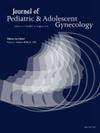Functional Ovulatory Menstrual Health Literacy Amongst Adolescent Females in Western Australia
IF 1.7
4区 医学
Q3 OBSTETRICS & GYNECOLOGY
引用次数: 0
Abstract
Study Objective
To assess the knowledge of ovulation and menstruation of adolescent females in Western Australia.
Methods
A validated adolescent ovulatory menstrual health literacy questionnaire was used in a cross-sectional study, which included an open-response question inviting participants’ reflections.
Results
Participants (n = 297) were from two single sex and seven coeducational schools of varied socio-educational advantage. Mean chronological age was 15 years and mean gynecological age was two years. The prevalence of dysmenorrhea was 69%. Primary sources of information included mothers (91%), friends (61%), and for postmenarchel participants (n = 274), mobile applications (52%). Most adolescents enjoyed finding out information about ovulatory menstrual health, and understood the information given to them. However, participants’ knowledge of ovulation, menstruation and their occurrence in the cycle were low. Attendance at a single sex or Catholic school or use of mobile applications did not confer a knowledge advantage overall (P < .05), except for knowing the meaning of cervical mucus. Thematic content analysis of open-ended responses resulted in five themes, including normality, menstrual flow, charting, ovulation, and dysmenorrhea.
Conclusion
Inadequate functional ovulatory menstrual health literacy hampers progression to acquiring complete health literacy. This has negative implications for progressing towards the interactive and critical ovulatory menstrual health literacy domains, which include providing an accurate menstrual history when engaging with healthcare providers.
西澳大利亚青少年女性的功能性排卵月经健康知识。
研究目的评估西澳大利亚州青少年女性对排卵和月经的了解程度:方法:在一项横断面研究中使用了经过验证的青少年排卵期月经健康知识问卷,其中包括一个开放式回答问题,请参与者进行反思:参与者(n=297)来自两所单一性别学校和七所男女同校的学校,社会教育优势各不相同。平均年龄为 15 岁,平均妇科年龄为 2 岁。痛经发生率为 69%。主要信息来源包括母亲(91%)、朋友(61%),而对于初潮后的参与者(人数=274),则包括移动应用程序(52%)。大多数青少年喜欢查找有关排卵期月经健康的信息,并能理解向他们提供的信息。然而,参与者对排卵、月经及其在周期中的出现的了解程度较低。就读于单一性别学校或天主教学校或使用移动应用程序并没有带来知识上的整体优势(p 结论:功能性排卵月经健康知识不足阻碍了逐步获得完整的健康知识。这对实现互动性和关键性的排卵期月经健康知识领域具有负面影响,这些领域包括在与医疗服务提供者接触时提供准确的月经史。
本文章由计算机程序翻译,如有差异,请以英文原文为准。
求助全文
约1分钟内获得全文
求助全文
来源期刊
CiteScore
3.90
自引率
11.10%
发文量
251
审稿时长
57 days
期刊介绍:
Journal of Pediatric and Adolescent Gynecology includes all aspects of clinical and basic science research in pediatric and adolescent gynecology. The Journal draws on expertise from a variety of disciplines including pediatrics, obstetrics and gynecology, reproduction and gynecology, reproductive and pediatric endocrinology, genetics, and molecular biology.
The Journal of Pediatric and Adolescent Gynecology features original studies, review articles, book and literature reviews, letters to the editor, and communications in brief. It is an essential resource for the libraries of OB/GYN specialists, as well as pediatricians and primary care physicians.

 求助内容:
求助内容: 应助结果提醒方式:
应助结果提醒方式:


